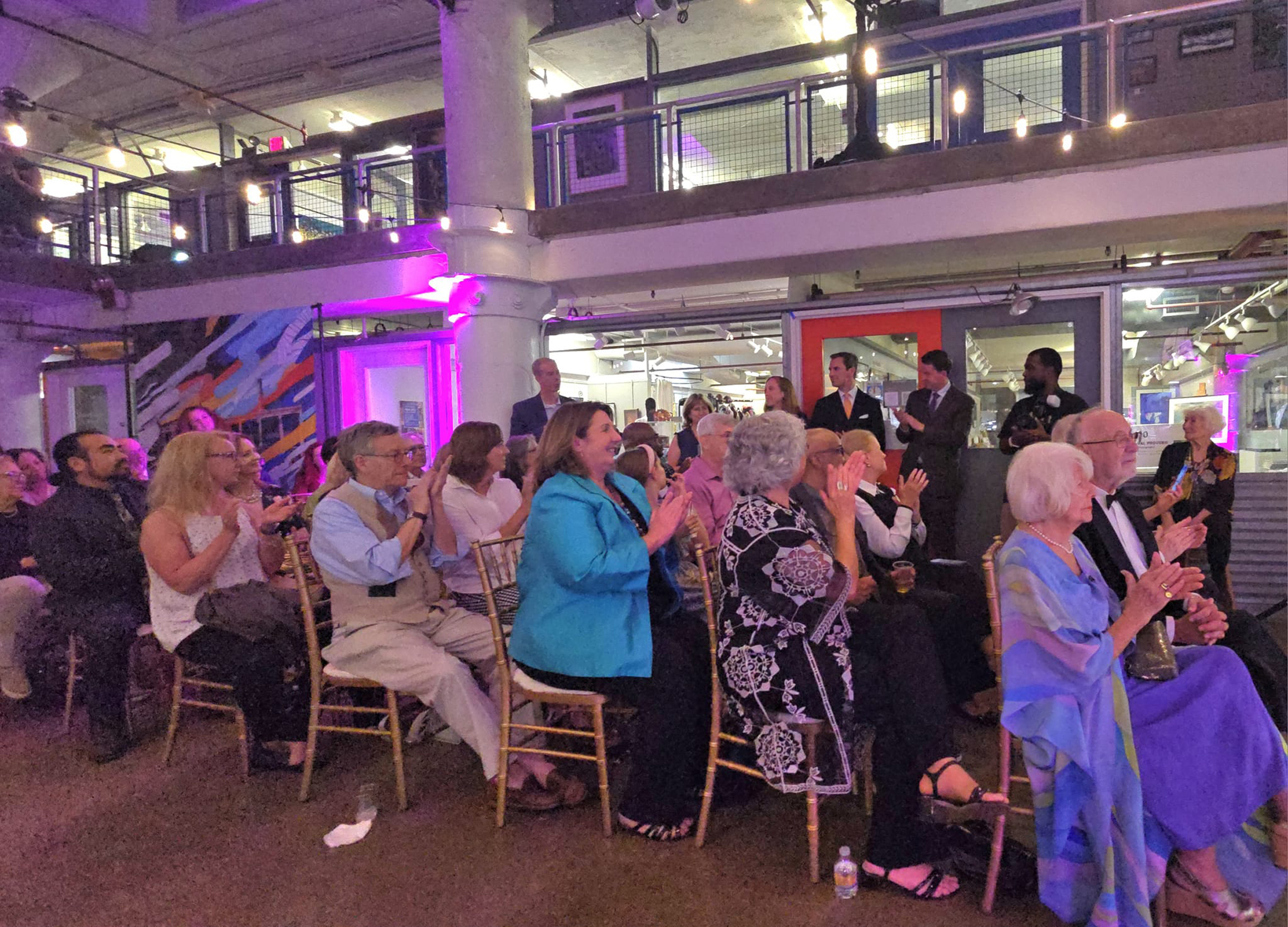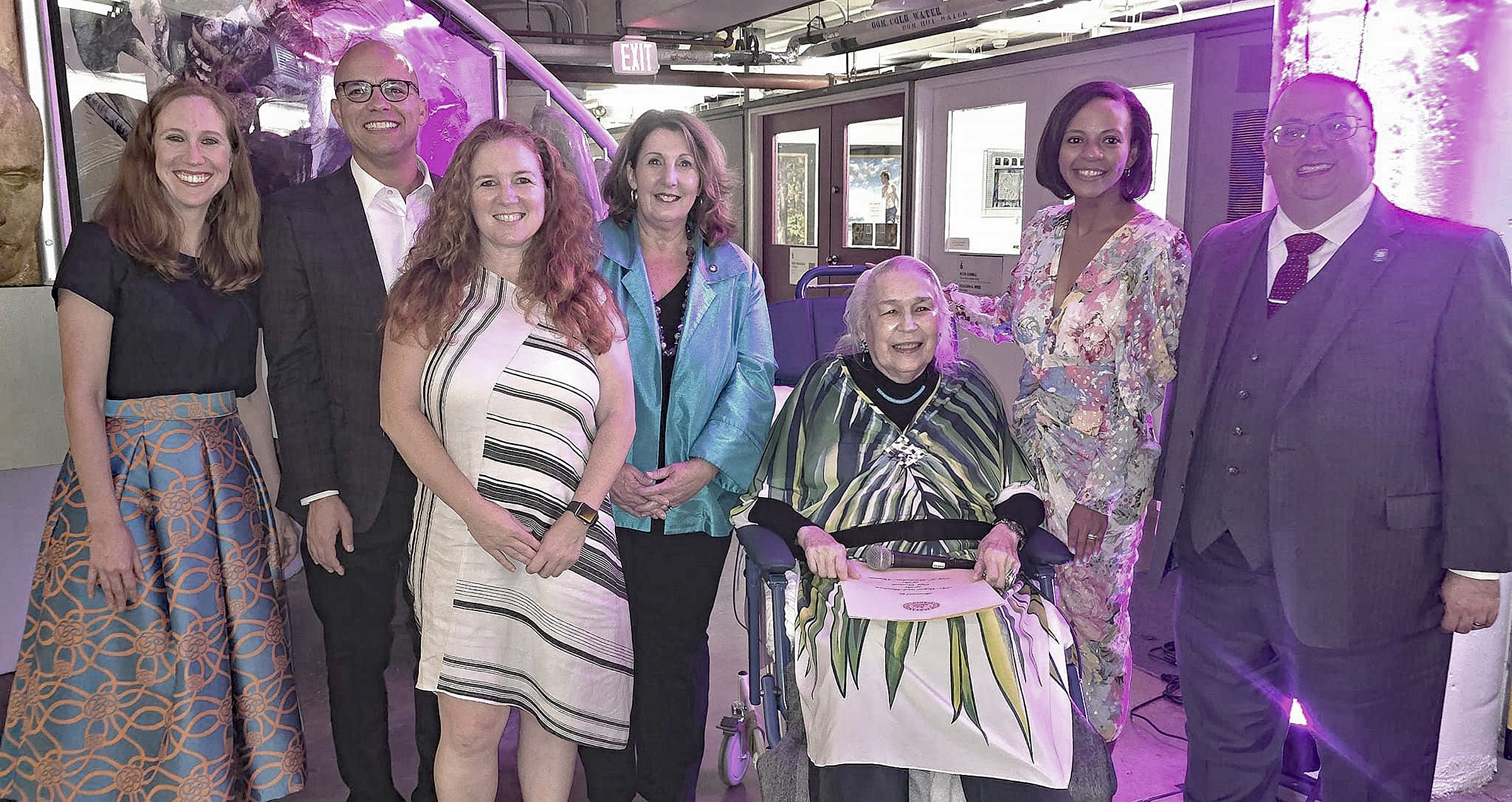Torpedo Factory Celebrated 50th Anniversary In September!

Alexandria, VA – “When we look for similar models, we can’t find them. When we’re looking to compare the Art Center to something or see how other folks are doing it, there’s nothing like this out there. It stands alone for what it is. It’s kind of hard to compare it.” Diane Ruggiero, Deputy Director of Recreation, Parks & Cultural Activities – Office of the Arts
As I walked down Union Street Saturday evening September 14, headed for the Torpedo Factory Art Center’s 50th anniversary private party, my mind took me back to 1999. My daughter is seven years old. I drop her off at the Torpedo Factory for a morning art class. I stop for coffee and walk the historic streets of Old Town for hours until she’s done. We get lunch. Then I take her to Madison Avenue for her afternoon art class. It is summer and my child cannot get enough art. She is fascinated by the architecture of the Torpedo Factory, the history, and stands quietly at the door of an artist’s studio, afraid to disturb. But the artist beckons the shy girl to approach as he patiently explains his craft.
Sunday September 15, the iconic art center turned 50 and to celebrate, the former munitions plant was the scene of a lively three-day party. The festivities kicked off Friday the 13th with a free outdoor 1970s-themed festival. “No bad luck. It was all good,” Diane Ruggiero laughed, grateful for the sublime weather. She is deputy director of Recreation, Parks & Cultural Activities – Office of the Arts, who masterminded the weekend birthday extravaganza.
“It was a fun party. We had a full house. Some had never been to the Art Center but because of the 50th anniversary, it became a good excuse for folks to come and check it out,” Ruggerio told Zebra. “While we had folks that have known about the Art Center for all of 50 years, we still had some people visiting for the first time.”

Two days later, the public was invited back to the historic structure for more outdoor merriment to mark the milestone birthday. In between, the Torpedo Factory closed to the public at 5:00 pm that Saturday as staff readied the large art space for an invitation-only affair. It was a veritable Who’s Who of Alexandria. City officials, dignitaries, community leaders, and artists partied it up and paid homage to the creation of a thriving dynamic art center in the heart of the city’s historic district.
“As I was walking down King Street, I walked past hordes of people enjoying life, restaurants on the 100 block, I got down to the end, I made the turn, looked to the right, saw the incredible park, the new Boat Club and all that is happening. I turn to the left and I walk through the Torpedo Factory,” Mayor Justin Wilson began in his welcoming remarks.
“If you fell off a spaceship here tonight, you would appreciate all the amazing stuff that is happening here in Old Town. But you would forget that it wasn’t always this way.”
The hallmark of the evening was a tribute to Marian Van Landingham, who was the Art League president and driving force behind the creation of the art center in 1974.

“Before there were hordes of people enjoying restaurants on King Street, before there were amazing parks, before there was beautiful new development, there was the Torpedo Factory,” the mayor recalled. “The Torpedo Factory was a foundational element to the renaissance of the Alexandria waterfront that we all take for granted and it is what continues to bring people to Old Town. That is a miracle that began with Marian Van Landingham and the other founders.” The crowd erupted in applause.
In 1973, The Art League had a lease at 315 Cameron Street that was expiring. James Coldsmith, chair of the Alexandria Bicentennial Commission, suggested to Art League President Marian Van Landingham that she look at the city-owned dilapidated torpedo plant. Van Landingham pitched the idea as a three-year pilot to Mayor Charles Beatley Jr. and it passed City Council on May 7, 1974.
“I haven’t used a mic in a while,” Marian Van Landingham began, to a burst of laughter from the audience. “I was thinking, as we sit here, about how the factory evolved. Looking around, it is so wonderful now. And I’m wondering if you could envision what it was like before we came in. I said back then that there was no place for artists to go. I was looking at every pigeon-filled place that I could find that was for rent. I had to find a place that was fairly cheap and here in Old Town. It wasn’t easy. Jim Coldsmith said, ‘Why not the Torpedo Factory? The city doesn’t know what to do with it.’”

Mayor Wilson offered up a proclamation to Marian Van Landingham, praising her vision and doggedness to create an art center at the run-down former torpedo factory.
Van Landingham thought back to 50 years ago. “I had not seen it. I knew there was something on the waterfront down there but no one went to the lower blocks of King Street. It was abandoned. So I jumped on a bicycle and rode down Cameron Street. Luckily there was a gate. I didn’t hesitate. I walked right through that door. I got in and I was astounded. The sheer size, the high ceilings, and of course the dead pigeons.”
As the project to fashion the Torpedo Factory into a prominent art center took shape, the City hired Van Landingham as director, where she held the position for one year. She then won a seat in the Virginia General Assembly where she remained for 24 years. Delegate Elizabeth Bennett-Parker now holds that seat and presented Van Landingham with a state proclamation.

Attending the exclusive bash, in addition to the mayor and Virginia Delegate Bennett-Parker, were elected officials Alexandria Vice Mayor Amy Jackson, Councilmembers Alyia Gaskins, Sarah Bagley, and R. Kirk McPike, State Delegate David Bulova, State Senator Jeremy McPike, and City Manager James F. Parajon.
When the last guest said goodbye, Diane Ruggiero, who’d spent all day preparing for the elegant reception, was finally able to kick back and talk to Zebra about the Art Center and what it has given the city of Alexandria.
“It’s not uncommon for industrial cities to take the arts and use it as a way to transform a city. But nobody was doing that in 1974.”
“Nothing compares to it,” Ruggiero pointed out. “There’s a couple of things that make it unique. One is that the building is owned by the municipality so that’s very uncommon to see. The other is that it’s full of leased artist studio spaces in the building which is again very uncommon.”
ICYMI: Alexandria Choral Society and NOVA Symphony Orchestra Perform Beethoven’s 9th Sunday, Nov. 10





[…] SEE ALSO: Torpedo Factory Celebrated 50th Anniversary In September Post Views: 0 TagsAlexandria Daily Alexandria Daily Updates Alexandria Dining Alexandria Dining News Alexandria events Alexandria news Alexandria News Weekly Alexandria newspaper Alexandria Va News Emily Calloway local news Local News Alexandria Local newspaper Alexandria US Navy Zebra Send an email 5 seconds ago0 2 minutes read Facebook Twitter LinkedIn Tumblr Pinterest Reddit Pocket Messenger Messenger WhatsApp Share via Email Print Share Facebook Twitter LinkedIn Tumblr Pinterest Reddit VKontakte Odnoklassniki Pocket Messenger Messenger Share via Email Print […]